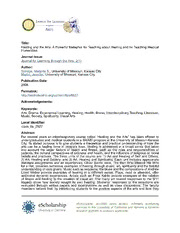
ERIC EJ1094965: Healing and the Arts: A Powerful Metaphor for Teaching about Healing and for Teaching Medical Humanities PDF
Preview ERIC EJ1094965: Healing and the Arts: A Powerful Metaphor for Teaching about Healing and for Teaching Medical Humanities
Title: Healing and the Arts: A Powerful Metaphor for Teaching about Healing and for Teaching Medical Humanities Journal Issue: Journal for Learning through the Arts, 2(1) Author: Sirridge, Marjorie S., University of Missouri, Kansas City Martin, Jennifer, University of Missouri, Kansas City Publication Date: 2006 Permalink: http://escholarship.org/uc/item/8pb882j1 Acknowledgements: Keywords: Arts, Drama, Experiential Learning, Healing, Health, Illness, Interdisciplinary Teaching, Literature, Music, Society, Spirituality, Visual Arts Local Identifier: class_lta_2527 Abstract: For several years an interdisciplinary course called “Healing and the Arts” has been offered to undergraduates and medical students in a BA/MD program at the University of Missouri-Kansas City. Its stated purpose is to give students a theoretical and practical understanding of how the arts can be a healing force in people's lives. Healing is addressed in a broad sense that takes into account the larger factors of health and illness, such as the roles and responsibilities of patients, the cultural perspectives of sickness and health, and the influence of religious or moral beliefs and practices. The three units of the course are: 1) Art and Healing of Self and Others; 2) Art, Healing and Society; and 3) Art, Healing and Spirituality. Each unit includes appropriate literature assignments and art experiences. Oliver Sacks' book, The Man Who Mistook His Wife for a Hat, provides numerous examples of healing through music, art, spirituality and the helpful understanding of care givers. Music such as requiems, the blues and the compositions of Andrew Lloyd Weber provide examples of healing in a different sense. Plays, read or attended, offer additional dynamic experiences. Artists such as Frida Kahlo provide examples of the relation of illness and healing to the creation of visual art. The many art related responses to the 9/11 tragedy show how society sought its own healing. Students’ responses to the selections are evaluated through written papers and examinations as well as class discussions. The faculty members believe that, by introducing students to the positive aspects of the arts and how they eScholarship provides open access, scholarly publishing services to the University of California and delivers a dynamic research platform to scholars worldwide. have universally contributed to the healing of individuals, societies and cultures, they are teaching them the important balance between medical knowledge and the arts in their own lives. Copyright Information: All rights reserved unless otherwise indicated. Contact the author or original publisher for any necessary permissions. eScholarship is not the copyright owner for deposited works. Learn more at http://www.escholarship.org/help_copyright.html#reuse eScholarship provides open access, scholarly publishing services to the University of California and delivers a dynamic research platform to scholars worldwide. SSiirrrriiddggee aanndd MMaarrttiinn:: HHeeaalliinngg aanndd tthhee AArrttss:: AA PPoowweerrffuull MMeettaapphhoorr ffoorr TTeeaacchhiinngg aabboouutt HHeeaalliinngg ...... INTRODUCTION TheUniversityofMissouri-KansasCity(UMKC)hasanestablishedhistoryof interdisciplinarydialogueabouttheimportanceoftheartsandhumanitiesinsociety. Thegoalof theSchool’smedicalhumanitiesprogramistohelpstudentsrealizethattheycanunderstandthe humanconditionthroughliterature,thefineandperformingartsandotherhumanitiesexperiences ,andthattheconceptofhealingismuchbroaderinitsscopethanthediagnosisandthetreatment ofillnesses.Thisarticlewilldescribeanelectiveinterdisciplinarycoursethatbothliberalartsand healthcareprofessionalstudentscanchoose. Medicalstudentsinthe6-yearB.A./M.D.program areencouragedtoincludeitintheircurricula. Thecourseiscalled“HealingandtheArts,”anditsstatedpurposeistogivestudentsa theoreticalandpracticalexperienceofhowtheartscanbeahealingforceinpeople’slives.Using theartstopromotehealingisnotanewtopicforhealthprofessionals1-8. Howeverinterweaving themetaphorofhealingandtheartsthroughoutanentirecourseisquiteunique.Thecourse focusesonhowhealingcanbesupportedbydifferentexperiencesoftheartsratherthancentering ononekindofartastherapy (e.g.,drama,,poetry,artormusictherapy). HISTORICALBACKGROUND In1976,theRockefellerFoundationconvenedameetingofpersonsinterestedinmedical humanitiestoconsiderthevariousrolesoftheartsinhealingandtherapeuticenvironments. “The HealingRoleoftheArts,”anarrativedefiningwhatthehealingartsareandhowtheycanbestbe employedinAmerica,waspublishedafterthissession. Thepointofcommonalityamongall participantswasthattheartsareessentialforwell-being. Relateddiscussionsexploredthe importanceofartas“process,”notartwithacapital“A”. Theuseofartasasymbolofpersonal and/orsocietalstrugglewasseenasmoremeaningfulthanartforitsaestheticvaluealone. Despitedifferingopinionsindefiningthehealingarts,allparticipantsagreedthat“artisan intrinsicattributeofhumanexistence”9. Laterdiscussionsatthemeetingfocussedon“howtomeasurethevalueofthe arts.”Severalpeopleexpressedtheirfrustrationwithbeingunabletotranslatetheirpersonal experiencesintoharddata. Twenty-sevenyearsafterthisstudy,thesameproblemexistsin academicinstitutionsacrossthecountry. Wheneducationand“assessment”co-exist,thearts oftenfallshort,becauseit’sdifficulttotest“empathy,”“positivehealing,”andotheraspectsof 1 11 JournJaol ufornr aLle faorrn Linega rtnhirnogu gthhr othueg hA rthtse, 2A(r1ts),, A2(r1ti)c l(e2 01076 ()2006) artisticlearning.9.Unfortunately,inmedicaleducation,objectivemeasurementremainsthe primarygoal,10especiallyindeterminingrequiredofferingsforcurricula.Thisshouldnot, however,preventeducatorsfromtryingtodesignmoresensitivewaysofdeterminingoutcomes. Anotherimportantareaofconversationcenteredaround“artbeyondcuring,”thenotion thathealthcareentailsmorethancuringaspecificillnessordisability. Oneparticipantsaidthat “healing”goesbeyondtheinstitutionalpopulation;therapeutichealingisacontinuumandshould reacheveryonewhoneedsit,notjustsickpeoplewhoareinhospitals9. Asmedicalcaremoves outofhospitalsintolongtermcarefacilitiesandhomes,thisconversationbecomesevenmore important. COURSEDESPRIPTION Thethreestatedobjectivesofthecourseare1)Toanalyzethearts,howtheyfunctionfor individualsandsociety,whattheirvariousrolesare;2)Tofullyexperiencethehealingforceof theartsaftergainingknowledgeaboutthehistoryandcontextofthearts;and3)Todevelop empatheticresponsestoartisticmediums. Thefacultyseekstohelpstudents“buildbridges,” connectingtheirownliveswiththeartexperience. Formanystudentstoday,particularlythose trainedinthesciences,exposuretotheartsbothintellectuallyandemotionallyisa"brandnew" experience. Theyneedtolearntoaskwhataworkofartisabout,aswellastolearnsomething aboutitshistoryandhowitcanhaverelevancetotheirday-to-daylives. Thecourseprovides toolstounderstandtheprocessesartistsusetocommunicateandtoidentifythemesthatare relevanttohealingasstudentsviewand/orexperiencethearts. ThesegoalsofthecourserelatetowhatP.AnneScottsaysin“TheRelationshipBetween MedicineandtheArts,”thattheartsencouragewhole-person understandingaswellashelping studentstorecognizeandlearnfromindividualpatientexperiences. Sheusestheterm “enrichmentoflanguageandthought”andarguesthatliteratureandthefineandperformingarts canenrichthelanguageand,thus,thethoughtprocesses,ofhealthcareprovidersinamannerthat providesa wealthofconceptsandideaswithwhichtothinkabouthealthcare11.Scottconcludes herarticlebyquotingRSDownie:“Medicineandarthaveacommongoal:tocompletewhat naturecannotbringtoafinish....toreachtheideal...tohealcreation.Ifweareattentivein looking,inlisteningandinwaiting,thensoonerorlatersomethinginthedepthsofourselveswill respond.Art,likemedicine,isnotanarrival;it'sasearch”12. Inordertoelicitstudents’assumptionsatthebeginningofthecourse,theyareaskedto completethefollowingtwosentences: “Healingis…..” and“Artis…..”. Atthebeginningofthe 2 22 SSiirrrriiddggee aanndd MMaarrttiinn:: HHeeaalliinngg aanndd tthhee AArrttss:: AA PPoowweerrffuull MMeettaapphhoorr ffoorr TTeeaacchhiinngg aabboouutt HHeeaalliinngg ...... semester“art”evokesassociationssuchas“emotion,”“truth,”“beauty”and“essence,”whereas “healing”isoftenequatedwith“curing.”Duringthesemester,studentsareaskedtodescribetheir responsestosomethingthey'vereadorexperiencedandareremindedoftheirinitialdefinitions andhowtheymaybeshiftingtheirviews. Suchactivitycanbeveryuseful,particularlywhen studentsareencouragedtoemployapersonalvoiceinansweringsuchquestionsandwriting aboutthem.Bytheendofthesemester,theroleofarthasmovedfromageneraltoamore personalaesthetic,onethathasspecificmeaningtothestudent. Theshiftthatoccursinstudents’perceptionof“art”alsooccursintheirdefinitionsof “healing.”Sooften,whenillnessoccurs,theterm“curing”isusedinsteadoftheterm“healing.” Whereascuringmakestheassumptionofapositiveoutcome,healingpresumesawholemind, body,andspiritualapproachtowellbeing. Asalreadymentioned,healingisabroader,more inclusivetermthattakesintoaccountthelargerfactorsofhealthandillness,suchastherolesand responsibilitiesofthepatient,theculturalperspectivesofsicknessandhealthandtheinfluenceof religiousormoralbeliefsandpractices. Thiscourseusestheartsasaprimaryunifyingprinciple toexpandthehealingconceptandtakeitbeyondtherealmofmedicine,emphasizingtheways thattheartshaveservedthroughouthistoryandcontinuetoserveaspositivemediumsfor healing. . The“HealingandtheArts”courseisdividedintothreelargeunits:1)ArtandHealingof SelfandOthers;2)Art,HealingandSociety;and3)Art,HealingandSpirituality. Withinthese largerunitsareavarietyofchoicessuchasthereadingofOedipus,TheKing,theviewingof FridaKahlo'sartworkandlearningherlifestoryandthereadingofselectionsfromOliverSacks’ TheManWhoMistookhisWifeforaHatinUnitI;discussionof society’sneedforRequiems, thesignificanceoftheAIDSquiltandtheimportanceof differentkindsofhealingviewsfor cancer andAIDSpatientsinUnitII;andthesearchforpersonalredemption inAndrewLloyd Webber’smusic,spiritualityintheartandritualofNativeAmericansandmanyotherethnic groupsandculturesinUnitIII. Therearetwofacultymembers,onefromTheaterandonefromtheMedicalHumanities, whoparticipateinallclasssessions. Inaddition,thereareguestspeakerswhobringparticular strengthsandabilitiesinspecificareasofthearts. Foramedicalapproachthroughliterature, OliverSacks’clinicalstoriesinTheManWhoMistookHisWifeforaHathelpstudentscometo knowthispersonwhoseeshimselfasbothadoctorandhealer,thusleadingthemtore-evaluate theirtraditionalmethodsofinterpretinga“good”physician. StudentswhocometoseethatSacks asacarefulobserverandinterpreterofhumanexperiencecancomparethisapproachtothemore traditionalscientificapproachtohealing,e.g.,interpretingtestsandgivingpills. Another 3 33 JournJaol ufornr aLle faorrn Linega rtnhirnogu gthhr othueg hA rthtse, 2A(r1ts),, A2(r1ti)c l(e2 01076 ()2006) exampleofthehealingroleisdescribedbyphysicianKateScannellinherbook,TheGood Doctor. Sheseeseachpatientasa“problem”that,althoughshecan’tcure(sincemostofher patientsintheearly1980sweredyingofAIDS),shecantrytoheal. Anotherstory,Richard Selzer’sImagineaWoman,doesn’thaveadoctorasthecentralcharacter,butapatientwhois dyingofAIDS.Thispatientattemptstohealherself,butfindsthatmanypeopleandevents aroundherprovidethenecessaryhealingcomplement. Inthese,andother,examples,literaturebecomesanexperienceofhealingandshowsthe waysthattraditionalmedicalmodelsoftenignorethelesstangibleorpracticalaspectsofhealing selforothers. Ifstudentsreadaboutsuchcharactersandhowtheyaffectchangesintheir attitudesaboutthemselvesandtheirhealth,theyfindmodelstohealthemselvesandothers. Sometimesitismoreeffectivetouseatextthathasnomedicalcharacterspresenttoallow studentstoseethathealingisuniversalandtakesplaceoutsideofhospitalsanddoctor'soffices allthetime.Healingsooftenrequiresmorethanmedicalcare. Theperformingartscanofferamoredynamicexperiencetostudentsthanreading literaturealone. Forexample,watchingOedipusTheKingchallengesstudentstoidentifywith theprotagonist,exploretheirownfeelingsofhubrisandexperiencethejudgmentoftheon- lookers. Abluesmusicianhelpsstudentsunderstandthesourceandhealingpoweroftheblues andthenleadstheminthecreationandperformanceoftheirownblueslyrics. Amorepersonal experiencecanoccurwhenstudentsdoalivereadingoftheplay,JourneyintoThatGoodNight, astoryaboutaterminallyillcollegestudentwhofindscomfortandhealinginpoetry. Withtoday’sgenerallydiversestudentbody,ithasbecomeachallengetofindacore experiencetowhichallstudentscanrelate,withtheexceptionoftheSeptember11thattacksinthe UnitedStates. Thissharedexperiencehasprovidedapowerfulunifyingmetaphorthatall studentscanrelateto. ArecentarticleinTheNewYorkerbyAlexRoss,entitled“Requiems,” asks:“Whatdoesmusicgiveuswhenwordsarestoppedinourthroats?Onanordinaryday, musictakesusoutofourselves,allowingustoforgetwhateverself-inventeddramasmaybe pressingonus. Theeffectisseldomlasting. Butwhenweareallinthegripofthesameemotion, musiccanshouldertheheaviestpartofwhatwearefeeling.”13. Otherexamplesof 9/11-related artisticoutpouringsareincluded,suchaspaintings,poems,photographsandshortstoriesthat haveaddressedthistragedyintheirownways. Aswithmanyotheractivitiesinthecourse,therequirementofthewrittenassignmentsis includedtoteachstudentshowtolookatworksofartandtheirrelationshiptohealing. Special exhibitsarechosenatnearbyartgalleries,andattendanceatatleastoneplayduringthesemester isrequired. Musicalconcertscanalsobechosen.Studentsarerequiredtoattendandreporton 4 44 SSiirrrriiddggee aanndd MMaarrttiinn:: HHeeaalliinngg aanndd tthhee AArrttss:: AA PPoowweerrffuull MMeettaapphhoorr ffoorr TTeeaacchhiinngg aabboouutt HHeeaalliinngg ...... twosuchexternalartexperiences.Responsepapersrequireadescriptionoftheexperienceand whatpersonalmeaninghasbeengleaned.Therearethreelongerpapersthatdrawoutsomeofthe interrelatedthemesofthecourse,suchastherolesofartinthehealingofindividualsandsociety andoftheimportanceoftheartsinthespiritualdimensionsofhealing.Therearealsothreeunit tests,non-cumulative,whichfocusmorepracticallyonanalyticalunderstandingofmaterial. Thereareidentificationquestions,aswellasessayquestions,thatrequireananalysisofthe readingsandmaterialpresentedanddiscussedinclass. ANALYSISOFTHECOURSE Facultymembersbelievethatbyfirstintroducingstudentstopositiveaspectsofthearts andhowtheyhavemadeauniversalcontributiontohealingindividuals,societies,andcultures throughouttime,andtheninvitingself-exploration,theyarehelpingstudentslearntheimportant balancebetween“knowledge”and“experience.”Withoutknowledgeit’sdifficulttounderstand another’sorevenone’sownexperiences. Withoutexperientialconnectiontotopics,it’sdifficult toconveytostudentsagenuineunderstandingofhowtheartscanbeahealinglifeforce. When dealingwithhealthandillness,itisimportanttogivestudents.i.e.futureorcurrentpatientsand healers,abatteryofresources. If,forinstance,someindividualsareorganizingasupportgroup, theymayneedtochooseaplay,musicpiece,artwork,orworkofliteraturethatwillbemost effectiveinfocusingandsharingexperiences. Also,aspectsofpersonalhealingandsharingin thehealingoffamilyandfriendsarealwaysofcentralimportance. Manypeoplearguethatthereisanevengreaterneedforhealingtoday,sincepeopleina globaleconomytendtobesegregatedandlessconnected,connectingmoretotheircomputers, gadgets,andtelevisionsetsthantoeachother. Inthefieldofhealth,particularly,manypeople arguethattheskillofwholebodyhealinghasbeenlostintheobsessionwithmedicaltechnology andthescientificapproachtohealing. Thiscourseoffersasolutiontothatlackofbalance. It providesoneavenueforeducatorstoremindstudentsthattheartsofferanotherwaytotapinto positivemodesofhealing. It’simportanttoeducateourselvesandourstudentsaboutcreativeand healingforcesandtorecognizehowwecanusethesetoolstohelpusrespondtoourownpain andsufferingandthatofothers. CONCLUSION Theartshavealwaysfunctionedasapositivemethodforhealingthemind,body,and spirit. Themainpurposeofthedescribedcourseistohelpstudentsbecomeacquaintedwith 5 55 JournJaol ufornr aLle faorrn Linega rtnhirnogu gthhr othueg hA rthtse, 2A(r1ts),, A2(r1ti)c l(e2 01076 ()2006) manydifferentworldviewsofhealing. Afurthergoalistogetpre-healthandhealthcarestudents tostepawayfromtheirisolationismtoseethelargerhumanisticpictureofhealthandillness. For pre-medicalandmedicalstudentstosharetheclasswithnon-medicalstudentsoffersanunusual opportunitytoenlargetheexperiencesforboth.Whenstudentsconnecttothemainstreamof peopleandhumanexperiences,theyfindthathealthandillnessarelargerthemesthatencompass allofsociety. Sincehealingdoesnotalwaysmeanstayingonthesideoflife,butlettinggoofour needtocontrol,ithelpsstudentstotalkaboutsomethingotherthanmaladies. Instead,itguides themtofocuson ahealthyversionofthemselvesandothersthatmayleadeachgroupof individualstofindtheirownwholeness. Facultywhohaveparticipatedinthiscoursefeelthat whenstudentshaveunderstoodconceptsconceptuallyandanalytically,theyarethenenabledto experiencethepracticalandexperientialcomponentsofhealingfromthearts.Thus,anattemptis madetoconveyknowledge abouthealingconceptsfirst,beforeexploringtheseartisticmediums throughreading,writing,discussingandexperiencing. Itisalsotheintentionofthecoursetohelpstudentsexperiencethehealing,ennobling andenrichingaspectsofthearts.Allhumanbeingsareartiststovariousdegrees,sincetheycreate andre-createtheirresponsestotheworld. Thefacultyhasencouragedstudentstoidentifyand developpersonalskillsthattheycanutilizeintheirday-to-daylivesandsharewithothers. References 1. HollemanWL. Theplay’sthething:usingliteratureanddramatoteachaboutdeathand dying. FamilyMedicine2000Sep;32;8:523-4. 2. BoisaubinEV,WinklerMG. Seeingpatientsandlifecontexts:thevisualartsinmedical education. AmericanJournaloftheMedicalSciences2000May;319;5:292-6. 3. BlochS.ShouldmedicalstudentsreadPlato? MedicalJournalofAustralia1999May17;. 170;10:512. 4. AndersonCM. “Fortyacresofcottonwaitingtobepicked”:medicalstudents,storytelling, andtherhetoricofhealing. LiteratureandMedicine1998;17;2:280-97. 5. Coles R. Themoraleducationofmedicalstudents. AcademicMedicine.199;73;1:55-7. 6. JarrettP. Artscoursesforstudentsandclinicians. Lancet1996Jul27;348;9022:27127. 7. MorrisK. Musecallingmedics:newUKfocusonhumanitiesinmedicine.Lancet1999Nov 6;354;9190:1651. 6 66 SSiirrrriiddggee aanndd MMaarrttiinn:: HHeeaalliinngg aanndd tthhee AArrttss:: AA PPoowweerrffuull MMeettaapphhoorr ffoorr TTeeaacchhiinngg aabboouutt HHeeaalliinngg ...... 8. StanfordAF,BraunerDJ,ChambersTS,DonnellyWJ,HunterKM,PoirerS,etal. Reading literarytheory,readingIvanIlych;oldwineinnewwineskins.Caduceus1994;10;3:161-78. 9. TheHealingRoleoftheArts.NewYork:RockefellerFoundation;1978. 10. Kuper A. LiteratureandMedicine:aproblemofassessment. AcademicMedicine2006Oct; 10;Suppl81:5128-5137. 11. ScottPA. Therelationbetweenmedicineandthearts.JournalofMedicalEthics2000;26;1: 3-8. 12. DownieRS.TheHealingArts:AnOxfordIllustratedAnthologyOxford:OxfordUniversity Press;1994. 13. RossA. Requiems. TheNewYorker2001Oct8:78-80. 7 77
